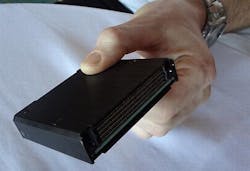2015 expected to be breakout year for VITA 74 VNX small-form-factor embedded computing
THE MIL & AERO BLOG, 20 Jan. 2015. Long-anticipated VITA 74 VNX small-form-factor embedded computing technology should see its first major design wins this year, driven by applications in land vehicles and manned aircraft, industry experts say.
VNX is a VPX-like embedded computing standard designed to meet needs for extremely small size, weight, and power consumption (SWaP) in rugged mobile applications in military, transportation, and industrial automation.
The first major military contract design-ins for VNX are in negotiation today, and should be announced sometime this summer. "2015 will be the breakout year for VNX wins, with deliveries in 2016," says Bill Ripley, director of business development at CES Creative Electronic Systems SA in Geneva, Switzerland.
Ripley made his comments Monday at the Embedded Tech Trends conference in Phoenix. CES and Themis Computer in Fremont, Calif., are today's most prominent suppliers of VNX technology, but more embedded computer companies are expected to enter the VITA 74 market as the technology begins to take off later this year.
Between CES and Themis, VNX has about 12 aerospace and defense design-ins, which cannot yet be detailed because of contract negotiations. Upcoming VNX contract announcements will involve "a very large number of boxes," and will play major roles in jump-starting the fledgling VNX industry, Ripley says.
Up to now the major design-ins for VNX have involved embedded computers for military land vehicles, as well as display processors and mission computers for military manned aircraft, Ripley says. Surprisingly, the technology has not caught on yet in unmanned vehicle applications, he says, but that is expected to change as VNX technology catches on.
The pending VITA 74 VNX open-systems industry standard describes single-board computers and other embedded computing circuit cards that are about the size of a deck of playing cards; in other words a VNX card is about half the size of a VPX board.
The standard includes two kinds of boards -- one with a connector measuring 19 millimeters high, and the other measuring 12.5 millimeters high.
The VNX standard -- like VME and VPX -- is overseen by the VITA Open Standards and Open Markets industry trade group in Fountain Hills, Ariz. The standard should be formally validated, adopted, and distributed to industry by early 2016, Ripley says.
VNX is a companion to the VITA 73 and VITA 75 small-form-factor embedded computing standards. VITA 75 pertains to small-form-factor embedded computing enclosures, and VITA 73 involves a separate small-form-factor board design.
Ripley says VNX is not intended to replace other open-systems embedded computing standards like VPX. Instead, he says VNX will augment VPX, and shares several traits with VPX to facilitate interoperability among boards built to the two standards.
VNX, for example, is electrically identical to VPX, Ripley says. It's connector, however, is smaller than VPX, and can be purchased at about one-tenth the cost of a VPX connector, Ripley contends. VNX also has the VITA 57 FPGA Mezzanine Card (FMC) connector, and can accommodate COM Express Mini mezzanine cards.
One of the biggest advantages of VNX will be its ability to implement systems-on-chip (SOC) embedded computers involving general-purpose processors and field-programmable gate arrays (FPGAs) in military and aerospace applications, Ripley says.
The circuit cards could be implemented in backplane databus systems like a VITA 75, in proprietary designs, or could be packaged in single-card systems that could be applied to SWaP-constrained applications like small unmanned aircraft or wearable computing.
"Adoption of VNX will be faster than it was for VPX, and VNX has a growing following," Ripley says. VNX will be able to accommodate processors including the AMD Fusion G series, the quad-core third-generation Intel Core i7, as well as the Power PC processor.
For more information contact the Embedded Tech Trends conference online at www.embeddedtechtrends.com, CES Creative Electronic Systems at www.ces.ch, the VNX Marketing Alliance at www.vita.com/vnx, or the VITA trade organization at www.vita.com.

John Keller | Editor
John Keller is editor-in-chief of Military & Aerospace Electronics magazine, which provides extensive coverage and analysis of enabling electronic and optoelectronic technologies in military, space, and commercial aviation applications. A member of the Military & Aerospace Electronics staff since the magazine's founding in 1989, Mr. Keller took over as chief editor in 1995.



